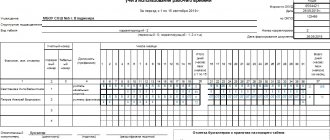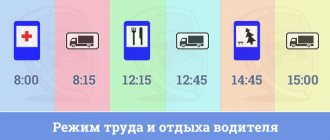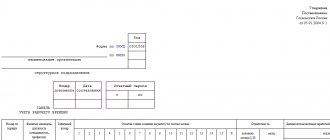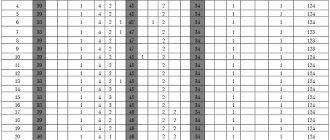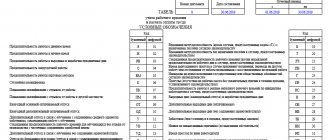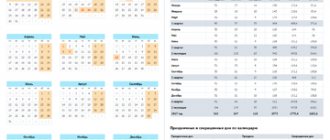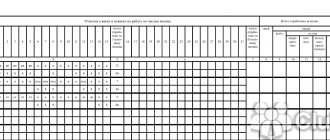Time sheets serve as the basis for calculating salaries for employees. This document contains information about the presence of employees at their workplaces or their absence, indicating the reason. To fill out, you can use the unified form T-13 or form T-12. As part of this article, we will look in detail at the features of filling out the T-13 time sheet, and we will give an example of filling out a working time sheet using the T-13 form as an example. In addition, you can use both forms below.
A time sheet is a table in which attendance and absence from work are taken into account for each employee of an enterprise. The total number of days and hours worked for the month is displayed. In addition, codes for the reasons for absence from work are indicated.
About the time sheet form T 13 excel
The working time sheet, form T 13 excel, was developed and approved by the State Statistics Committee of the Russian Federation and enshrined in the resolution of 01/05/2004.
The document is a unified form for recording employee labor costs. The accounting sheet can serve as the main documentation for calculating wages, accounting for overtime, bonuses and de-bonuses of employees. Download link:
If you need a standard time sheet for working days/hours , you can select and download the appropriate one by clicking on the appropriate links in the articles: - Time sheet in days - Hourly time sheet excel (photo of the day) - Time sheet taking into account night shifts - Timesheet calculation and shift planning
Online magazine for accountants
Why do you need a time sheet? A time sheet, approved by Resolution of the State Statistics Committee of January 5, 2004 No. 1, helps the personnel service and accounting department of the enterprise:
- take into account the time worked or not worked by the employee;
- monitor compliance with the work schedule (attendance, absence, lateness);
- have official information about the time worked by each employee for calculating wages or preparing statistical reports.
It will help the accountant confirm the legality of accrual or non-accrual of wages and compensation amounts for each employee. The HR officer must track attendance and, if necessary, justify the penalty imposed on the employee. A time sheet refers to the forms of documents that are issued to an employee upon dismissal along with a work book upon his request (Article 84.1 of the Tax Code of the Russian Federation). It is necessary to ensure that the surnames and first names of employees are correctly indicated, avoiding the possibility of confusion among employees with the same surname.
- For each employee, information about his personal file number is entered.
- Each column of the timesheet corresponds to a specific day of the month.
- The cells opposite the names contain information about the hours worked, the number of shifts, and if there are weekends and holidays, the corresponding marks are entered.
- Information about the work actually performed is entered every day, based on the official documents provided (sick leave certificates, orders, statements, management orders).
- Cases of tardiness and absenteeism are also subject to reflection in the form of letter and numeric codes.
- The document is considered valid if it is signed by the authorities.
A much more serious punishment awaits if the mandatory time sheet was not kept at all. The amount of the fine can be up to 50 thousand rubles, levied on the managerial person on the basis of Art. 5.27
Code of Administrative Offences. In order to avoid problems with fiscal authorities and financial auditors, it is necessary to monitor the timely submission by employees of documents that can justify any discrepancy from the standard designation of working hours. Article 5.27. Violation of labor legislation and other regulatory legal acts containing labor law standards. If the timesheet is filled out manually, drafts and copies are used.
Features of filling. Time sheet form T 13 excel
Let's look at the features of filling out the timesheet. At the top of the timesheet, general information about the organization is indicated: name, OKPO code, as well as document number, date of preparation of the timesheet and the reporting period from the first to the last day of the month.
Next comes the main table for tracking employee working hours. The table is filled out according to the accepted form of numbered sections:
- Section No. 1 - the serial number of the record is indicated;
- Section No. 2 - full name and position of the employee;
- Section No. 3 - employee personnel number;
- Section No. 4 - the employee’s attendance and absence from work are recorded according to the dates of the month;
Form T-12
This form template was developed by Rosstat, decision No. 247 of July 13, 2010.
The form provides recording of data on monitoring the labor regime in the company. If the structure of the company includes separate divisions that operate independently and carry out their own accounting of incoming funds and costs from their activities, filling out the TURV is carried out for each link separately.
The results of the completed timesheets are sent by institutions to the local structures of Rosstat or to the corresponding higher structures of the company.
The head of the company issues an order to appoint an authorized person who is entrusted with control over the labor regime in the company, with the subsequent sending of statistical reports to the state. structures.
Instructions for filling out the time sheet according to form T-12
To fill out the TURV in 2022, use an option that is more comfortable for this company:
- With daily display of information about staff attendance/absence at work and hours worked.
- With registration of information only in case of deviation from the approved operating mode of the company. This option is ideal for companies with the same working regime for the majority of employees.
Registration of arrival at the company is carried out in the timesheet by entering coded symbols into the form. Moreover, recording is carried out only for officially employed workers, including those with internal combinations.
The work activities of the following personnel are not monitored:
- Unofficially employed.
- Accepted for external part-time work.
- Persons with whom a civil agreement has been concluded.
To fill out the TURV, an order is issued from the director of the company, which appoints an authorized person responsible for this area of work. This may be a personnel employee, or a structural manager, or another person. Based on the coding established in the form, the company’s accounting department calculates salaries and other accruals.
Thanks to the company’s method of maintaining TURV, the document is drawn up either in one common form (for the entire company), or in several forms, separately for each structural link.
The completed timesheet is submitted to the accounting department every month after the end of the month. The preparation of the report card begins with the correct filling of the title page and the tabular part of the report card.
Front page
The following information is recorded in this part of the form:
- Company name.
- Enterprise codes OKUD and OKPO.
- Document number assigned by the company.
- Reporting period – i.e. month during which personnel activities are recorded.
- The date of registration of the timesheet, which is most often the end date of the reporting month.
All information is filled in the appropriate columns on the title page:
- So, at the top of the report card the full name of the company is written, and in brackets is its short name.
- The next line contains the name of the structural unit.
- The company code number (OKPO) is filled in based on the all-Russian Rosstat classifier.
In the same way, the company identification code is filled in, as well as the form number, the date of execution of the document and the reporting period.
Table page
This section of the form looks like a table where you need to make entries in all the columns:
- The first column is intended for recording numbers in order.
- The second and third columns display the details of the working person, filling in the full name, position and personnel number assigned to each working person.
- The 4th and 6th columns are used to record symbols indicating the attendance/pass of personnel to work, where the code is filled in in the numerator, and the number of hours worked in the denominator.
- The 5th and 7th columns serve to display the number of working days and hours worked for the corresponding period of the month.
- From column 8 to 13, the final results of labor activity for the month are recorded, displaying the days and hours worked at the company.
- The 14th column records the missed days and hours, reflecting the reasons that are noted in the 15th and 16th columns.
- Column 17 records the number of weekends and holidays.
After filling out the form, authorized persons are required to sign it and record the date of execution.
Conventions. Employee attendance and absence. Time sheet T 13
Let's look at the symbols of the time sheet t 13. In section No. 4, 4 lines are allocated for each employee. The first two lines contain data on attendances and absences for the first half of the month from the 1st to the 15th. In the second and fourth - from 16 to the end of the working month. In the first line of each half of the month (line 1 and 3), a conventional letter designation (appearance/absence code) is entered, in the second line (line 2 and 4) - the duration of the working or non-working day according to this code in hours. See the full list of notations here. The designations and procedure for filling out the working time sheet are advisory in nature and can be replaced by the employer depending on the method of recording working time in the organization.
How to keep a timesheet
By law, the employer has the right to choose one of the following methods:
- continuous - registration of appearances, absences and any deviations from the normal work schedule, such as work on holidays, overtime, business trips;
- by deviations - registration only of absences, overtime and other deviations from the standard work regime.
In practice, everyone uses the continuous method, and accounting for deviations is almost never used. This is due to the fact that personnel records are almost completely automated, and electronic processing of forms T-12 and T-13 does not allow leaving empty cells. However, when recording working hours in aggregate, when the number of hours worked in different shifts may differ from the norm, a continuous method should be used. This will allow you to see possible overtime after the end of the accounting period and adjust the further involvement of the employee in work.
Estimated indicators. Data for calculating salary. No-shows due to reasons
Blocks No. 5-13 are also filled in for each half of the month (yellow and blue areas in the figure below). Block No. 5: the first line is the number of days of attendance for half a month, the second line is the number of hours. Block No. 6 - the amount for the entire month (yellow cell - the sum of days, blue - the sum of hours). Based on the data received, blocks No. 7-9 “Payroll by types and areas of costs” are filled in. Here you need to indicate the payment type code, the corresponding invoice, and enter the calculated days/hours. This is followed by columns No. 10-13 of the “Absences for Reasons” block, which details the calculation of employee absences.
Time sheet T 13 and its certification. Signatories
After compiling the timesheet T 13, it must be approved and certified by 3 employees: the employee who is entrusted with the formation and maintenance of the timesheet, the direct head of the structural unit for which the accounting was compiled, and the employee from the HR department supervising the unit. Often, the head of a structural unit is the person responsible for the formation of the time sheet; the T-13 form allows this certification option. To do this, either indicate the manager in both signatory fields: the responsible person and the head of the department.
Which form of report card to choose
There is no need to conduct T-12 and T-13 at the same time, just select one of the forms. As a rule, the T-13 report card is used by those who have automated control of employee working hours using electronic access systems to the enterprise, for example, installing turnstiles or electronic locks. Those who fill out the timesheet manually use the T-12 form.
Another important difference between the forms is that accounting for wage calculations is provided in the T-12 form. And in T-13 they only keep track of working hours, while wages are calculated using other tools, but on the basis of a time sheet.
So if you work in an accounting program that combines payroll and time tracking, use Form T-12 and fill it out completely. If you keep track of working time and payments separately, you can use either form T-13, or only the first section of form T-12.
To track working time, it is not necessary to use a unified time sheet. The company has the right to adjust it or develop its own forms, approve them by internal regulations and use them instead of a time sheet. The main thing is to prove record keeping during a labor inspection inspection.
Automation of the process of constructing and filling out a time sheet, form T 13 excel
In order to avoid lengthy routine operations for generating a monthly time sheet, use an automation macro that automatically creates a sample “time sheet T 13” form based on your entered data for the selected month. To do this, you need to download the timesheet from the link below, fill out a simple form on the “Settings” page (picture below): list of employees, general information about the organization, signatories; select the required month and year and click the “Create timesheet” button.
Afterword
Thank you for reading this article. I look forward to your feedback and comments below. Downloading the program is absolutely free. I will be glad if this time sheet T 13 turns out to be useful for you. I will be happy to answer your questions and help you customize your accounting to suit your company’s needs .
This macro is just a modest demonstration of my automation skills in MS Excel. For more than 10 years I have been professionally involved in programming both in Excel and in the web (writing websites, parsing websites, writing bots, simulating user actions, etc.). I’m ready to take on any task, you can contact me through the website or write to me by email
Download link:
If you need a standard time sheet for working days/hours , you can select and download the appropriate one by clicking on the appropriate links in the articles: - Time sheet in days - Hourly time sheet excel (photo of the day) - Time sheet taking into account night shifts - Timesheet calculation and shift planning
Nuances
An additional sheet may be added to the main timesheet, which must be filled out for the employee upon his dismissal. At the end of the month, it is attached to the general time sheet, in which an entry is made for the retired employee “Dismissed”.
Employee absence from work
If an employee does not show up for work for an unknown reason, then in column 4 of the timesheet you need to enter the code “NN” or “30” - “Absences for unknown reasons.” After the employee confirms the reason for absence - sick leave, absenteeism, etc., corrections are made to the time sheet and the “NN” code is changed to the one corresponding to the reason for absence.
Illness while on vacation
If an employee fell ill while on annual leave and upon returning from it brought sick leave, in this case the indicated days of illness in the report card are marked with code (B) instead of the marked days of vacation (OT). In this case, the leave will be extended for the duration of the employee’s illness.
Celebration during vacation
If, in accordance with the production calendar, holidays fall during the vacation period, for example the May holiday, then these days are not included in the vacation - code (B) should be entered instead. The remaining days are also marked with the corresponding code (OT). So, for example, a vacation can fall on Russia Day if it is taken from June 11 to June 18. In this case, June 13 is marked with code (B).
